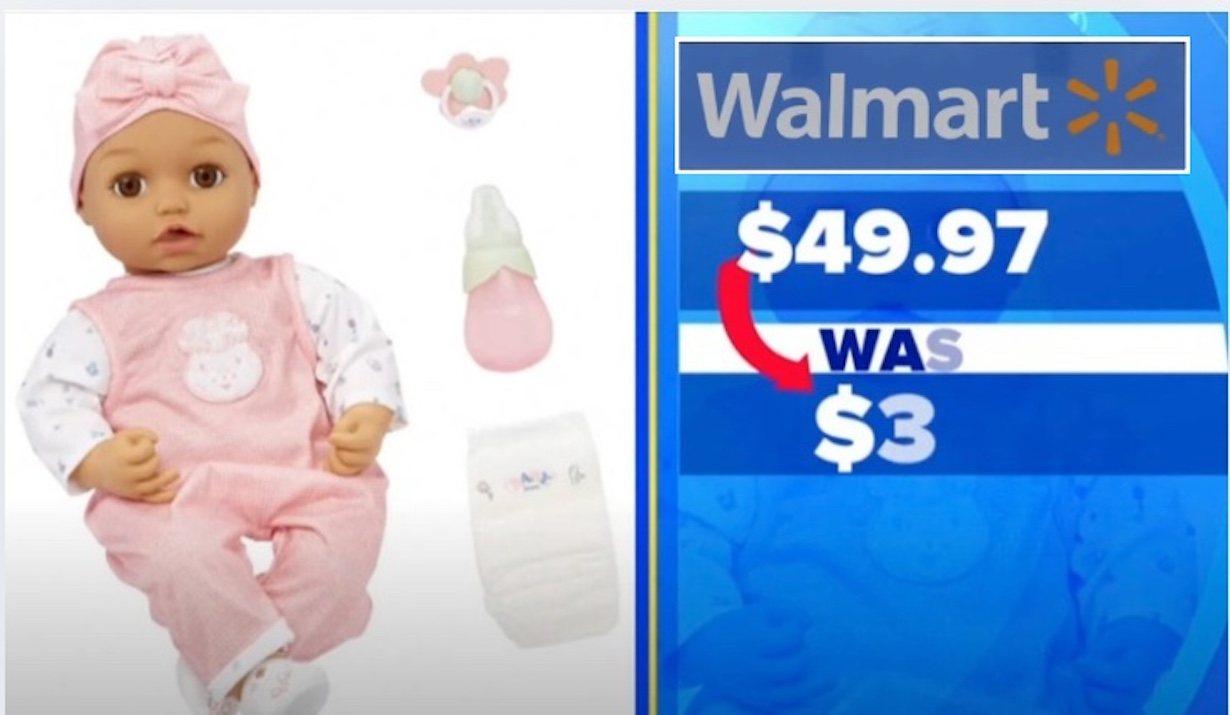

Walmart Raises Prices — Angry Shoppers Slam the Retail Giant (Photo: WHAS11/YouTube)
Walmart has quietly raised prices on many items in recent weeks. Shoppers noticed higher prices on toys, office supplies, and household goods. The hikes came after the U.S. placed a 145% tariff on Chinese imports in April. Even though the tariff dropped to 30% last month, Walmart did not lower prices. Instead, the company increased prices by as much as 134% in some cases. This has angered many customers. Former President Trump also criticized retailers and told them to “eat the tariffs” rather than pass the cost to consumers.
Toys made in China were among the hardest hit. The price of a “Jurassic World” T. rex toy went from $39.92 on April 27 to $55 by May 21. That’s a jump of nearly 38%. Just last November, the same toy cost only $29.74. Other toys saw similar hikes. A “Baby Born” doll rose from $34.97 in March to $49.97 in May. That’s an increase of 43%. A Lite Brite Magic Screen went from $14.97 to $21.97, which is up nearly 47%. The classic Etch A Sketch now costs $24.99, up from $14.97, a 67% increase. These changes hit families with children the hardest. Many parents rely on Walmart for affordable toys.
Walmart also raised prices on office supplies and everyday essentials. A single roll of tape that once sold for $4.24 now costs $9.94. That’s a 134% increase. A heating pad that was $19.98 now sells for $24.96, a jump of 25%. A fishing reel that cost $57.37 in April now costs $83.26. Just a few months earlier, in March, the same reel sold for $51.12. These price increases affect not just parents but also office workers, students, and hobbyists. Customers feel the pinch in many departments.
Walmart did not announce these changes to the public. But the company confirmed them when asked. Walmart’s Chief Financial Officer John David Rainey said the hikes are “unprecedented.” He explained that Walmart always tries to keep prices low. However, he said rising costs and narrow profit margins make that difficult now. A Walmart spokesperson told Business Insider the company will keep prices as low as it can. But they also said they can’t ignore the financial pressure from the tariffs and other market changes.
Former President Trump strongly criticized Walmart and other retailers for raising prices. He said big companies should absorb the cost of tariffs instead of passing it on to customers. Trump spoke out after Walmart’s CEO warned that prices could rise due to the new import levies. But Walmart went ahead with the price hikes anyway. This has created tension between major retailers and political leaders. It also highlights the challenge of keeping prices stable during a global trade dispute.
The White House did not comment directly on Walmart’s price hikes. Instead, they pointed to a recent interview with Treasury Secretary Scott Bessent. On CBS’s “Face the Nation,” Bessent said inflation has actually gone down. He pointed to the Personal Consumption Expenditure index, which dropped to 2.1%. That’s the lowest level in seven months. Bessent said the inflation fears are overblown. He said recent data shows prices are falling, not rising. This statement does not match what many shoppers see in stores.
Retail experts say tariffs may not be the only cause of Walmart’s price hikes. Prices can rise for many reasons, including supply chain problems, higher demand, or production delays. Experts also say listed prices don’t always show how much tariffs influence final costs. Still, the timing of Walmart’s hikes suggests that tariffs played a key role. This has renewed public debate about trade policy and consumer pricing.
Walmart says 60% of the products it sells in the U.S. come from American suppliers. The company has worked for years to reduce its dependence on Chinese imports. However, analysts say complete independence from China is almost impossible for big-box stores. Many products, especially electronics and toys, still come from China. Even small tariffs on these imports can lead to big price changes in stores.
Retail analyst David Bellinger from Mizuho Securities said the overall impact of the tariffs might stay small. He told clients the effect on consumer spending could be just a few percentage points. But even small changes hurt families who live paycheck to paycheck. Rising prices on toys, school supplies, and household items can add up fast. Consumers may start looking for cheaper alternatives or shop at other stores.
In the end, Walmart’s prices have clearly gone up. The hikes followed a steep tariff on Chinese goods. Trump demanded that retailers absorb the costs. Walmart refused. The company made over $15 billion last year and chose not to lower prices. Customers now face higher costs on everyday items. Experts say the full story includes more than just tariffs. But the result is the same—shoppers pay more at the checkout line.
Key Point Summary - D4vd Tesla body Police confirmed victim was a 5-foot-1, 71-pound woman…
Key Point Summary - Anna Kalinskaya tennis Kalinskaya says love can help players if relationships…
Key Point Summary - virgin lizard birth A female casque-headed iguana gave birth to eight…
Key Point Summary - Charlie Kirk assassination suspect Charlie Kirk, 31, shot dead at Utah…
Key Point Summary - wildfire aid scandal FireAid raised $100M with stars like Lady Gaga…
Key Point Summary - cruise passenger debt Passenger jumped ship in Puerto Rico to avoid…